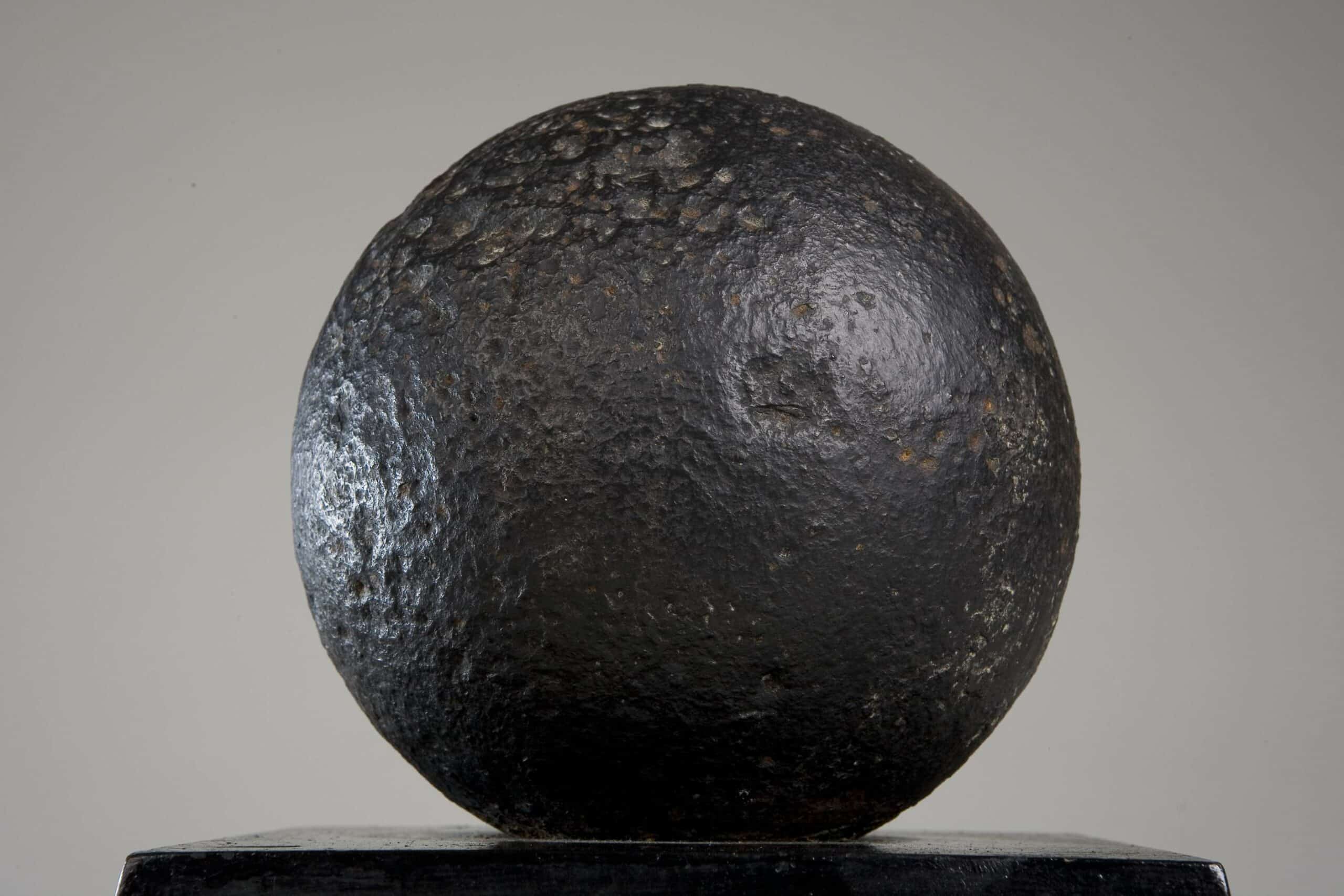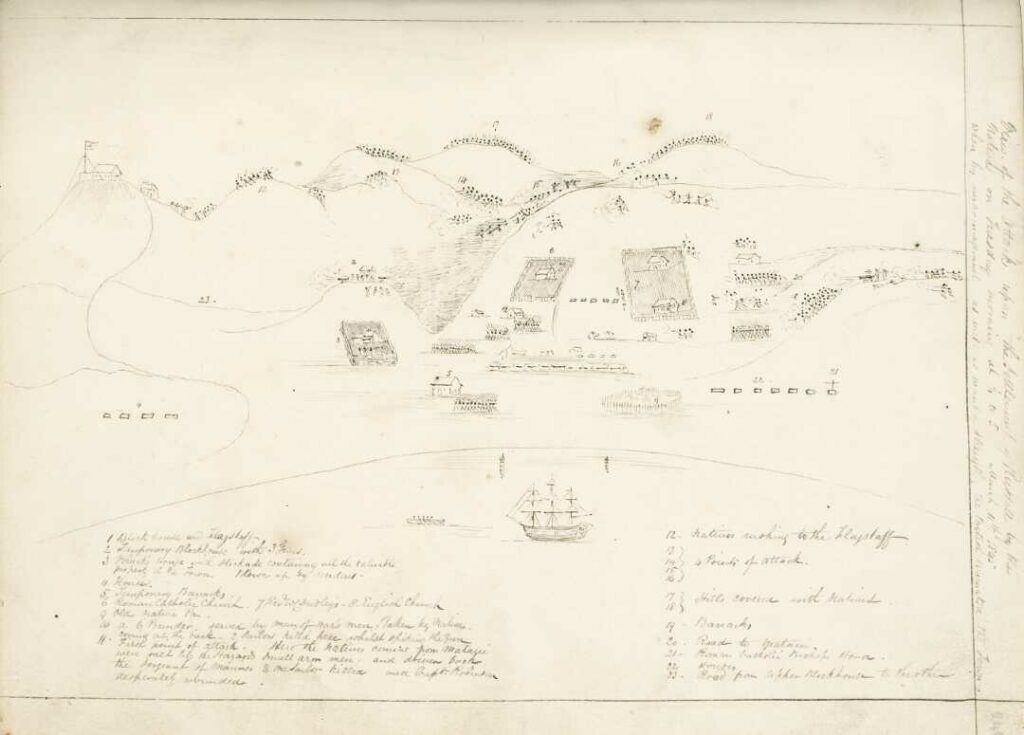This 178-year-old oak grave marker, originating from the beginning of the New Zealand Wars, was donated to the Navy Museum by the Council of Christ Church in 2022.
It was created to commemorate, and mark the resting place of, the sailors from HMS Hazard who died in the 1845 ‘Sacking of Kororāreka’ and was originally placed outside Russell’s church, Christ Church. Some decades later it was moved inside the building to prevent further degradation. Outside, a new stone marker was installed to replace the original. This bore the same inscription, although formatting and grammar were slightly adjusted.[1] The inscription of the original reads:
Colour Sgt. J.McArthy R.M.L.I. [Royal Marine Light Infantry] age 35
Pte. Alex May [R.M.L.I.] age 26
W. Lovell Seaman age 24
W. Love [Seaman] age 26
Whitkr. Denby [Seaman] age 34
Fredrick Geo. Minikin [Seaman] age 23
Late of / H.M.S. “Hazard” / who fell in the Defence of Kororareka / 11th March 1845
The warlike of the Isles,
The Men of Field and Wave.
Are not the rocks their funeral piles,
The seas and shore their grave?
Go, stranger track the Deep,
Free, free the white sails spread,
Wave may not foam nor wild wind beat,
Where rest not England’s dead.
Background:
HMS Hazard had been ordered to inhabit the bay at Kororāreka in response to growing tensions between the British Crown and local iwi Ngāpuhi.
Rangatira Hōne Heke, who was dissatisfied with British authority over the status and jurisdiction of Māori chiefs, had engaged in protest through cutting down the flagstaff upon the hill next to Russell which had begun flying the Union Jack since the Treaty of Waitangi was signed.[2]
After the flagstaff had been felled three times by Hōne Heke, Governor FitzRoy escalated the defensive precautions, erecting a blockhouse and stationing guards.[3] Early in the morning on the 11th of March 1845 Hōne Heke led a contingent of a few hundred fighters towards Kororāreka and, with the help of a strategic diversion force led by Te Ruki Kawiti at the southern end of the town, cut down the flagpole once again. The firefight which ensued after the Māori forces had overwhelmed the flagstaff guards and captured the upper blockade, resulted in a number of Pākehā casualties. Amongst these were the six Royal Navy seamen who are memorialised on the marker.[4]
Later that day the townspeople were evacuated to the ships in the bay – including HMS Hazard, another sloop-of-war Victoria, and later to a British whaling ship Matilda.[5] Shortly after the evacuees left the main stockade at ‘Mr Polack’s house’, which had housed the majority of the town’s residents, a store of gunpowder unexpectedly exploded completely destroying the building, luckily without any casualties.[6]
Spurred on by the recent destruction of one of their defensive positions the sailors and militia troops also headed for the ships.[7] Once all Pākehā were out of the town, George Phillpotts, commander of the militia – and in temporary command of the naval force after Hazard’s Captain David Robinson was wounded in the fray – ordered Hazard to bombard the town.[8] One of the cannonballs fired on this date is on display in the ABC Room at the Navy Museum.[9]
During this time the Māori forces began looting, although Heke stationed guards next to the local churches in order to specifically protect them from any pillaging.[10] British total losses over the course of the day were 19 or 20 killed and 23 wounded. As for Māori casualties reported there were around 13 dead and 28 wounded, however it is hard to be certain of the exact number as the contemporary press would inflate the statistics to more favourably represent the British.[11] Amongst the Māori dead was rangatira Pūmuka, allegedly killed by Captain Robinson.[12]
In response to the defeat at Kororāreka the British increased their northern military presence with reinforcements from Auckland.[13] This included the return of HMS Hazard to the Bay of Islands in April 1845.[14]
In an attempt to weaken the forces of Hōne Heke and Kawiti, Māori settlements such as Ōtuihu were shelled from the water even though the majority of Heke’s allies were already inland.[15] Heke’s pā at Puketutu was attacked in May where 200 British soldiers and seaman attacked with little success. Subsequently Heke withdrew to a pā near Te Ahuahu, which was claimed by Ngāpuhi and British who were allied when Heke went to look for supplies. On attempting to retake the pā Heke was badly wounded in the thigh.[17] Meanwhile Kawiti improved and reinforced a pā close to Ōhaeawai which was attacked by seamen and soldiers, including a contingent from HMS Hazard with HMS North Star, on July first.[18]
This assault was expertly repelled by Kawiti’s men and resulted in a Pākehā retreat.[19] In November of 1845 HMS Hazard was scheduled to sail for England via China, leaving the North Star and the Osprey at the Bay of Islands.[20] Hazard did not participate in the final Northern War battle which took place at Te Ruapekaka in January 1846. This final battle was followed by a peace agreement which saw an end to the war.[21]

-by Lewis Dunster, Collections Assistant
References:
[1]. ‘HMS Hazard NZ Wars memorial‘. New Zealand History, Nga Korero a ipurangi o Aotearoa. 2023. (Ministry for Culture and Heritage), 1 March. https://nzhistory.govt.nz/media/photo/hms-hazard-memorial.
[2]. ‘Origins of the Northern War’. New Zealand History, Nga Korero a ipurangi o Aotearoa. 2017. Ministry for Culture and Heritage, 18 August. https://nzhistory.govt.nz/war/northern-war/origins.
[3]. ‘The sacking of Kororāreka‘. New Zealand History, Nga korero a ipurangi o Aotearoa. 2019. Ministry for Culture and Heritage, 2 April. https://nzhistory.govt.nz/war/northern-war/sacking-kororareka.
[4]. ‘Sacking of Kororareka‘. Northern Advocate, (Newspaper). 1934. 5 February. Page 6. https://paperspast.natlib.govt.nz/newspapers/NA19340205.2.18.
[5]. (Northern Advocate 1934).
[6]. (Northern Advocate 1934).
[7]. (Northern Advocate 1934).
[8]. The Royal Navy, a History from the Earliest Times to Present. Clowes, W. Laird (William Laird), Clements R. (Clements Robert) Markham, A.T. (Alfred Thayer) Mahan, and Herbery Wrigley. Wilson. 1897-1903. Vol. 6. Great Britain. Royal Navy. Page 347. https://archive.org/details/royalnavyhistory06clow/page/346/mode/2up. and ‘Phillpotts, George‘. A. B. Crawford, 1990. Dictionary of New Zealand Biography. Te Ara – the Encyclopedia of New Zealand. Accessed June 12, 2023. https://teara.govt.nz/en/biographies/1p15/phillpotts-george.
[9]. ‘He Rā Maumahara – Remembering the New Zealand Wars’. Bird, Callan. Torpedo Bay Navy Museum. https://navymuseum.co.nz/were-featuring/he-ra-maumahara-remembering-the-new-zealand-wars/.
[10]. ‘The sacking of Kororāreka‘. New Zealand History.
[11]. ‘The sacking of Kororāreka’, New Zealand History.
[12]. New Zealand History, Nga Korero a ipurangi o Aotearoa. 2023. ‘Pūmuka‘. 19 June. https://nzhistory.govt.nz/politics/declaration/signatory/p%C5%ABmuka.
[13]. Danny Keenan. ‘New Zealand wars – Northern war, 1854-1846‘, Te Ara – the Encyclopedia of New Zealand. Accessed 6 19, 2023. https://teara.govt.nz/en/new-zealand-wars/page-2.
[14]. ‘Phillpotts, George‘. A. B. Crawford, 1990.
[15]. Danny Keenan. ‘New Zealand wars – Northern war, 1854-1846‘.
[16]. Keenan. ‘New Zealand wars’.
[17]. Keenan. ‘New Zealand wars’.
[18]. ‘Phillpotts, George‘. Crawford.
[19]. Keenan. ‘New Zealand wars’.
[20]. Page 295. The Shipping Gazette. 1845. The Shipping Gazette and Sydney general trade list. 89. Vol. 11. 29 November. Accessed June 16, 2023. http://www.nla.gov.au/ferguson/14403897/18451129/00020089/1-4.pdf. and Page 2. ‘New Zealand’. The Straits Times. 1846. The Straits Times and Singapore Journal of Commerce. XL. Vol. 2nd. 31 January. https://eresources.nlb.gov.sg/newspapers/Digitised/Article/straitstimes18460131-1.2.13.
[21]. Keenan. ‘New Zealand wars’.
Bibliography:
Bird, Callan. n.d. ‘He Rā Maumahara – Remembering the New Zealand Wars‘. Torpedo Bay Navy Museum. https://navymuseum.co.nz/were-featuring/he-ra-maumahara-remembering-the-new-zealand-wars/.
Clowes, W. Laird (William Laird), Clements R. (Clements Robert) Markham, A.T. (Alfred Thayer) Mahan, and Herbery Wrigley. Wilson. 1897-1903. The Royal Navy, a History from the Earliest Times to Present. Vol. 6. Great Britain. Royal Navy. https://archive.org/details/royalnavyhistory06clow/page/346/mode/2up.
Crawford, A. B. 1990. ‘Phillpotts, George‘. Dictionary of New Zealand Biography. Te Ara – the Encyclopedia of New Zealand. Accessed June 12, 2023. https://teara.govt.nz/en/biographies/1p15/phillpotts-george.
Keenan, Danny. n.d. ‘New Zealand wars – Northern war, 1854-1846‘, Te Ara – the Encyclopedia of New Zealand. Accessed 6 19, 2023. https://teara.govt.nz/en/new-zealand-wars/page-2.
New Zealand History, Nga Korero a ipurangi o Aotearoa. 2023. ‘HMS Hazard NZ Wars memorial‘. (Ministry for Culture and Heritage), 1 March. https://nzhistory.govt.nz/media/photo/hms-hazard-memorial.
New Zealand History, Nga Korero a ipurangi o Aotearoa. 2017. ‘Origins of the Northern War‘. Ministry for Culture and Heritage, 18 August. https://nzhistory.govt.nz/war/northern-war/origins.
New Zealand History, Nga Korero a ipurangi o Aotearoa. n.d. ‘Pūmuka‘. Accessed June 19, 2023. https://nzhistory.govt.nz/politics/declaration/signatory/p%C5%ABmuka.
New Zealand History, Nga korero a ipurangi o Aotearoa. 2019. ‘The sacking of Kororāreka‘. Ministry for Culture and Heritage, 2 April. https://nzhistory.govt.nz/war/northern-war/sacking-kororareka.
Northern Advocate, (Newspaper). 1934. ‘Sacking of Kororareka‘. 5 February. https://paperspast.natlib.govt.nz/newspapers/NA19340205.2.18.
The Shipping Gazette. 1845. The Shipping Gazette and Sydney general trade list. 89. Vol. 11. 29 November. Accessed June 16, 2023. http://www.nla.gov.au/ferguson/14403897/18451129/00020089/1-4.pdf.
The Straits Times. 1846. The Straits Times and Singapore Journal of Commerce. XL. Vol. 2nd. 31 January. Accessed June 16, 2023. https://eresources.nlb.gov.sg/newspapers/Digitised/Article/straitstimes18460131-1.2.13.


